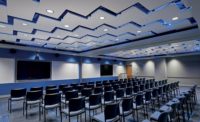Traveling to the north edge of Michigan State University’s campus, one will find a river that flows through it, the Red Cedar, and then later run by the street that divides the historic campus from downtown East Lansing, Grand River Ave. It is alongside the hustle and bustle of this avenue (which actually begins in Detroit) that MSU chose to build a 46,000-square-foot art facility—the Eli and Edythe Broad Art Museum. Hard to miss compared to its brick surroundings and location, the building is visually captivating with a steel pleated and glass window exterior formed into a sharp angular trapezoid.
Five years ago, MSU alumnus, entrepreneur and billionaire Eli Broad—along with his wife Edythe—donated $26 million to the university for the museum. After more fundraising and donations, MSU came up with a budget of $40 million for the project. London-based architect Zaha Hadid designed the structure.
Construction began in the Spring of 2010 but due to budget issues and design challenges, the project extended its original timeline and reached completion status in 2012.
(NEAR) PURE MICHIGAN
The majority of people working on the museum were from Michigan. Organized by the construction management team of Barton Malow, and led by Project Manager Gary Hatter, 32 different contract categories were filled. A local architect firm, Interior Design Solutions, kept in close contact with Hadid’s London headquarters to keep her vision intact.
Turner Brooks from Madison Heights, Mich., was chosen as the interior contactor with a contract for drywall, ceilings and door frames.
BIM software was used by all contractors. All the ceilings are sloped and pitched, with nothing really being flat or level inside the museum. The expectations and level of quality for the finished interior magnified the Level 5 of drywall finish on the ceilings, which also have recessed track lighting, Hatter says.
“Lafarge and USG drywall were used for all levels of finish requested,” Turner Brooks Project Manager Neal Bowlus says.
The walls and ceilings were an integral part of trying to coordinate trade contractors since Turner Brooks had to detail and box out for the light fixtures and linear diffusers. There was a lot of tandem layout between the MEP and drywall ceiling contractors that had to be exact, Hatter explains.
Most of the ceilings were installed with aerial lifts, Hatter says.
“There are 1,200 … to 2,000 square-foot ceilings in these galleries that had three to four times the normal commodities in them, and all had to be symmetrical and laid out in a fashion so the ceiling was supported by its own stud frame system,” Hatter says. “Ninety-five percent of the ceilings were installed off of aerial lifts, particularly because of heights that were on an average of 20 feet and in some cases 60 feet.”
NON-TRADIITONAL AND NON-LINEAR
This project was not completed in a linear fashion because of international products used and getting measurements correct on a building with such sharp angles everywhere. Hadid’s unique museum design was something most of the contractors had not experienced working with before, Hatter says.
“Communicating overseas and keeping in mind the angular design intent was a challenge,” he says.
In many cases trial-and-error techniques had to be used to complete the museum, as the angles had to be very precise or nothing else would fit together, Hatter says.
“Everyone in this industry is encouraged to go as fast as they can, because that usually means more profit,” says Hatter. “But for this project, we had to throw all that out the window and I think all the contractors really learned patience is a virtue.” W&C








Report Abusive Comment